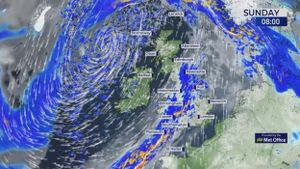Avian flu, particularly the H5N1 strain, has once again become a hot topic, particularly across North America where the virus is making its presence felt among livestock and, alarmingly, humans. Concerns about this strain have prompted scientists and health officials to keep their eyes peeled for signs of potential outbreaks and community spread, as evidence suggests the virus is adapting and might be inching closer to becoming transmissible between humans.
This month, reports emerged about two separate cases involving H5N1 infections in children from the Bay Area of California, and more critically, one involving a teenager from British Columbia. Both of these young individuals contracted the virus without any known exposure to infected animals, raising eyebrows and smacking some red flags up the mast about possible low-level community spread of the disease. "The big takeaway is there may be more community spread than is being detected," warned Dr. Abraar Karan, an infectious disease specialist at Stanford University.
The H5N1 strain, primarily affecting birds, can lead to severe health issues when transmitted to humans. While human infections remain rare, symptoms often range from mild to severe, potentially leading to pneumonia, organ failure, and even death. Compare this to the H7N3 strain, historically observed among poultry, which has typically led to milder symptoms among those infected.
Statistics from the Centers for Disease Control and Prevention (CDC) indicate there have been 55 confirmed cases of H5N1 bird flu among humans this year, with the overwhelming majority linked directly to farm workers who had close contact with infected poultry and cattle. Yet, three infections have surfaced where no clear source has been traced. Following the cases reported, health officials are ramping up monitoring. They have pledged extensive investigations and emphasized the necessity of vigilance as the pandemic season approaches, with potential for coinciding flu activity.
California has become the current hotspot, where the surge of H5N1 cases among dairy cows and other livestock has set alarm bells ringing. Reports mention over 600 dairy herds infected across 15 states and more than 100 million poultry affected nationally. Dr. Karan points out, "This virus seems to be increasing the number of animal species it's infecting and appears to be on the rise across geographic areas. Any time you see this kind of escalation, you have to be concerned about its future potential to spread among the human population."
Public health experts are now seeing the virus adapt, which could mean it’s exploring ways to improve its chances of transmission. There have been instances where the H5N1 variant has been detected outside typical hosts, such as swine. Pigs are known as "mixing vessels" due to their ability to contract pathogens from both avian and human sources—a genetic exchange creating conditions for new strains to emerge.
This is precisely the scenario health authorities dread, especially considering the historical tendencies of viruses, like the 2009 H1N1 outbreak caused by transmissibility among pigs, which led to widespread human infections. The situation echoes fears of past pandemics, provoking rapid responses from health departments across North America—including vaccine preparedness and surveillance protocols.
Although the CDC currently assesses the overall public risk as low, the reality is layered. The agency highlights the possibility of transmission methods beyond direct animal contact—something not entirely understood yet, as seen with some unexplained cases. Instances of human infections without evident connections to animals prompt the question: Are we on the cusp of another pandemic? Public officials are proactively addressing community health measures; the CDC advises avoiding sick or dead animals and has issued protective measures for those working closely with livestock.
When it centers around prevention, experts outline the necessary steps one can take. It boils down to fundamental precautions: preventing exposure to sick animals, practicing proper food safety techniques, and ensuring thorough cooking of poultry and eggs. Experts argue against raw milk consumption, which not only poses risks for contracting H5N1 but also carries broader health concerns.
Alarmingly, detection of the virus has been confirmed from poultry farms to raw milk sold at retail—marking firsts for H5N1 surveillance. Given this unsettling evidence, public authorities recommend vigilant observation should close contacts start to display any abnormal symptoms.
What weighs heavily on the minds of many is the ever-present threat of zoonoses—diseases transmitted from animals to humans—by simply operating within infected environments. This underlines the need for surrounding communities to collaborate with public health officials, ensuring any suspicious animal deaths or illness are reported to the relevant authorities, creating safety nets against potential outbreaks.
On the flip side, many stakeholders within the dairy and poultry industries are feeling the stress of these developments. Farmers grappling with infected herds often face uncertainty and potential economic fallout. Compensation programs from the USDA aim to alleviate some financial burdens, but there's often hesitation as reimbursements don't fully cover market losses or the expansive impact of lost production capacity.
Compounding these challenges is the heightened concern from the public affecting consumer confidence. This doubly pressures farmers who must manage disease protocols with the economics of food supply to transmute the current crisis. "When we perceive there’s any risk, it unravels everything," expressed one concerned farmer.
Health officials will be monitoring the evolution of the H5N1 strain closely, especially as holiday travel and gatherings loom on the horizons. It’s imperative, as scrutiny weighs heavily on those who have worked to monitor and contain the virus. They continue to advocate for increased responses, comparing the current situation to prior outbreaks and emphasizing preparedness for various scenarios.
Overall, the rising cases of avian flu and the corresponding health risks present both immediate and long-term concerns. While the risk of transition to human-to-human spread remains low for now, the unpredictability of avian flu and its adaptability highlight the importance of global awareness and response capabilities. Through close collaboration and adherence to safety guidelines, there's hope for mitigating risks. The watchful eyes of health officials and the cooperation of the public will prove instrumental as we navigate this murky terrain, ensuring the community remains informed and prepared.
Communities are encouraged to report symptoms early and engage with health departments for guidance on how to best reduce exposure risk. The intricacies of their interconnectedness underline the importance of continued communication and education surrounding avian influenza as we brace for what lies ahead.



